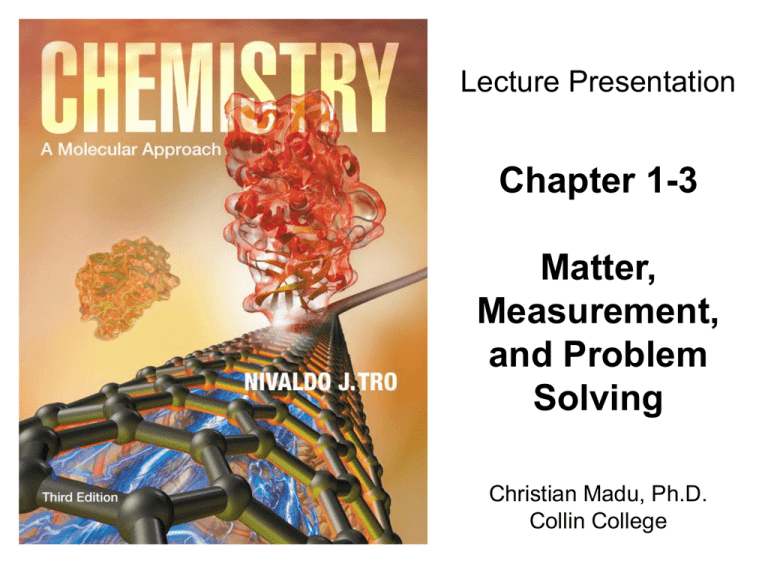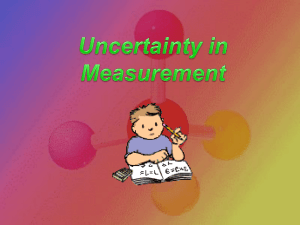dimensional analysis.
advertisement

Lecture Presentation Chapter 1-3 Matter, Measurement, and Problem Solving Christian Madu, Ph.D. Collin College Rules for Rounding • Round to two significant figures: 5.37 rounds to 5.4 5.34 rounds to 5.3 5.35 rounds to 5.4 5.349 rounds to 5.3 • Notice in the last example that only the last (or leftmost) digit being dropped determines in which direction to round—ignore all digits to the right of it. Rounding in Multistep Calculations • To avoid rounding errors in multistep calculations round only the final answer. • Do not round intermediate steps. If you write down intermediate answers, keep track of significant figures by underlining the least significant digit. Precision and Accuracy • Accuracy refers to how close the measured value is to the actual value. • Precision refers to how close a series of measurements are to one another or how reproducible they are. Precision and Accuracy • Consider the results of three students who repeatedly weighed a lead block known to have a true mass of 10.00 g (indicated by the solid horizontal blue line on the graphs). Student A Student B Student C Trial 1 10.49 g 9.78 g 10.03 g Trial 2 9.79 g 9.82 g 9.99 g Trial 3 9.92 g 9.75 g 10.03 g Trial 4 10.31 g 9.80 g 9.98 g Average 10.13 g 9.79 g 10.01 g Precision and Accuracy • Measurements are said to be • precise if they are consistent with one another. • accurate only if they are close to the actual value. Precision and Accuracy • The results of student A are both inaccurate (not close to the true value) and imprecise (not consistent with one another). • Random error is an error that has the equal probability of being too high or too low. • The results of student B are precise (close to one another in value), but inaccurate. • Systematic error is an error that tends toward being either too high or too low. • The results of student C display little systematic error or random error—they are both accurate and precise. Solving Chemical Problems • Most chemistry problems you will solve in this course are unit conversion problems. • Using units as a guide to solving problems is called dimensional analysis. • Units should always be included in calculations; they are multiplied, divided, and canceled like any other algebraic quantity. Dimensional Analysis • A unit equation is a statement of two equivalent quantities, such as 2.54 cm = 1 in. • A conversion factor is a fractional quantity of a unit equation with the units we are converting from on the bottom and the units we are converting to on the top. Dimensional Analysis • Most unit conversion problems take the following form: Dimensional Analysis Units Raised to a Power: • When building conversion factors for units raised to a power, remember to raise both the number and the unit to the power. For example, to convert from in2 to cm2, we construct the conversion factor as follows:







